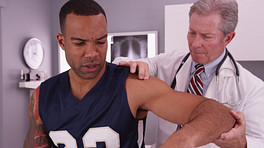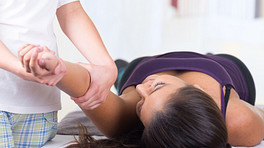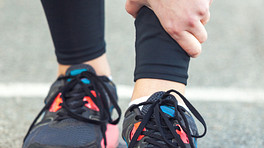The majority of patients are able to treat their shin splints with rest and other home-care methods, but some need help from medical professionals. Several of the treatments listed below can be done at home, while others require a doctor or physical therapist.
In This Article:
Cut back on training
Athletes should decrease training to a point where discomfort is no more than mild. This may require taking some time off running and sports. During this time, athletes can do non-impact cross-training, such as water running, cycling or using an elliptical machine.
Improve running form
Adjustments in running form can lessen the impact on the body, thereby decreasing the likelihood the shin splints will become chronic or more painful. For example, a running technique that lessens the risk of shin splints is to avoid footfall on the heel and move to the mid- or forefoot.
Use shin sleeves or shin wraps
These products provide compression and support for the lower leg and may decrease shin splint pain. Shin sleeves and wraps are available at sporting good stores and online.
Change shoes
Switching out athletic shoes for newer or different pair can decrease the impact when feet hit the ground.
Use shoe inserts
Like changing shoes, using inserts (orthotics) can help, especially for athletes with flat feet.
Ice
Applying a cold pack for 20 minutes two or three times a day can decrease inflammation.
NSAIDs
Over the counter NSAIDs can help relieve pain and control inflammation.
Stretching and strengthening exercises
Helpful exercises will stretch the calves and strengthen the lower leg muscles.
Electrical stimulation
This type of therapy is used to treat muscle pain and spasms, and may be helpful when damage to calf muscles is the underlying cause of shin splints.
Ultrasound
Concentrated, low ultrasonic frequencies stimulate blood flow, potentially promoting cell healing and speeding up recovery. Ultrasound therapy is different from ultrasound used for medical imaging.
Iontophoresis
This treatment uses a mild electrical current to push a topical steroid medicine into the affected shin(s).
Dry needling or acupuncture
Inserting ultra-thin needles into specific locations on the skin might relieve musculoskeletal pain and dysfunction, including shin splints.
Massage
Manual therapy and soft tissue massage can improve limitations in joint motion and flexibility.
A person suffering from shin splints may employ several of these treatment techniques at once. For example, a physical therapist may teach a patient stretching and strengthening exercises to be done at home and use appointment time for massage and ultrasound treatments.
See The P.R.I.C.E. Protocol Principles for acute injury treatment information
In cases that are unresponsive to conservative care or in cases with severe pain, doctors should consider testing for other causes of leg pain, such as stress fractures, exertional compartment syndrome, and the popliteal artery entrapment syndrome.









